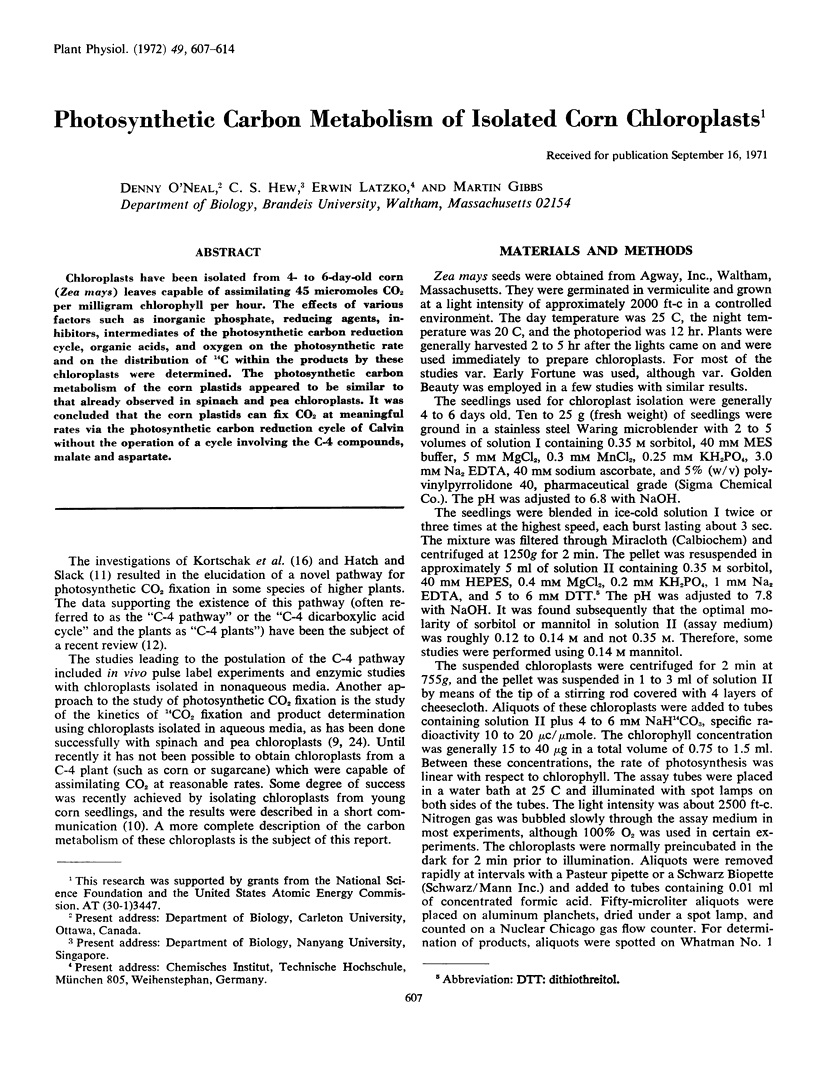Abstract
Chloroplasts have been isolated from 4- to 6-day-old corn (Zea mays) leaves capable of assimilating 45 micromoles CO2 per milligram chlorophyll per hour. The effects of various factors such as inorganic phosphate, reducing agents, inhibitors, intermediates of the photosynthetic carbon reduction cycle, organic acids, and oxygen on the photosynthetic rate and on the distribution of 14C within the products by these chloroplasts were determined. The photosynthetic carbon metabolism of the corn plastids appeared to be similar to that already observed in spinach and pea chloroplasts. It was concluded that the corn plastids can fix CO2 at meaningful rates via the photosynthetic carbon reduction cycle of Calvin without the operation of a cycle involving the C-4 compounds, malate and aspartate.
Full text
PDF







Images in this article
Selected References
These references are in PubMed. This may not be the complete list of references from this article.
- Baldry C. W., Bucke C., Walker D. A. Temperature and photosynthesis. I. Some effects of temperature on carbon dioxide fixation by isolated chloroplasts. Biochim Biophys Acta. 1966 Oct 10;126(2):207–213. doi: 10.1016/0926-6585(66)90056-2. [DOI] [PubMed] [Google Scholar]
- Bamberger E. S., Gibbs M. Effect of Phosphorylated Compounds and Inhibitors on CO(2) Fixation by Intact Spinach Chloroplasts. Plant Physiol. 1965 Sep;40(5):919–926. doi: 10.1104/pp.40.5.919. [DOI] [PMC free article] [PubMed] [Google Scholar]
- Cockburn W., Walker D. A., Baldry C. W. Photosynthesis by isolated chloroplasts. Reversal of orthophosphate inhibition by Calvin-cycle intermediates. Biochem J. 1968 Mar;107(1):89–95. doi: 10.1042/bj1070089. [DOI] [PMC free article] [PubMed] [Google Scholar]
- Edwards G. E., Lee S. S., Chen T. M., Black C. C. Carboxylation reactions and photosynthesis of carbon compounds in isolated mesophyll and bundle sheath cells of Digitaria sanguinalis (L.) Scop. Biochem Biophys Res Commun. 1970 May 11;39(3):389–395. doi: 10.1016/0006-291x(70)90589-9. [DOI] [PubMed] [Google Scholar]
- Ellyard P. W., Gibbs M. Inhibition of photosynthesis by oxygen in isolated spinach chloroplasts. Plant Physiol. 1969 Aug;44(8):1115–1121. doi: 10.1104/pp.44.8.1115. [DOI] [PMC free article] [PubMed] [Google Scholar]
- Gibbs M., Latzko E., O'Neal D., Hew C. S. Photosynthetic carbon fixation by isolated maize chloroplasts. Biochem Biophys Res Commun. 1970 Sep 30;40(6):1356–1361. doi: 10.1016/0006-291x(70)90015-x. [DOI] [PubMed] [Google Scholar]
- Hatch M. D., Slack C. R. Photosynthesis by sugar-cane leaves. A new carboxylation reaction and the pathway of sugar formation. Biochem J. 1966 Oct;101(1):103–111. doi: 10.1042/bj1010103. [DOI] [PMC free article] [PubMed] [Google Scholar]
- Heldt H. W., Rapley L. Specific transport of inorganic phosphate, 3-phosphoglycerate and dihydroxyacetonephosphate, and of dicarboxylates across the inner membrane of spinach chloroplasts. FEBS Lett. 1970 Oct 5;10(3):143–148. doi: 10.1016/0014-5793(70)80438-0. [DOI] [PubMed] [Google Scholar]
- Kortschak H. P., Hartt C. E., Burr G. O. Carbon Dioxide Fixation in Sugarcane Leaves. Plant Physiol. 1965 Mar;40(2):209–213. doi: 10.1104/pp.40.2.209. [DOI] [PMC free article] [PubMed] [Google Scholar]
- Kortschak H. P., Nickell L. G. Calvin-type carbon dioxide fixation in sugarcane stalk parenchyma tissue. Plant Physiol. 1970 Apr;45(4):515–516. doi: 10.1104/pp.45.4.515. [DOI] [PMC free article] [PubMed] [Google Scholar]
- Latzko E., Gibbs M. Level of photosynthetic intermediates in isolated spinach chloroplasts. Plant Physiol. 1969 Mar;44(3):396–402. doi: 10.1104/pp.44.3.396. [DOI] [PMC free article] [PubMed] [Google Scholar]
- Plaut Z., Gibbs M. Glycolate formation in intact spinach chloroplasts. Plant Physiol. 1970 Apr;45(4):470–474. doi: 10.1104/pp.45.4.470. [DOI] [PMC free article] [PubMed] [Google Scholar]
- SAKAMI W., LAFAYE J. M. Formation of formate and labile methyl groups from acetone in the intact rat. J Biol Chem. 1950 Nov;187(1):369–378. [PubMed] [Google Scholar]
- Schacter B. Z., Gibbs M., Champigny M. L. Effect of antimycin a on photosynthesis of intact spinach chloroplasts. Plant Physiol. 1971 Oct;48(4):443–446. doi: 10.1104/pp.48.4.443. [DOI] [PMC free article] [PubMed] [Google Scholar]
- WEISSBACH A., HORECKER B. L., HURWITZ J. The enzymatic formation of phosphoglyceric acid from ribulose diphosphate and carbon dioxide. J Biol Chem. 1956 Feb;218(2):795–810. [PubMed] [Google Scholar]
- Walker D. A., Crofts A. R. Photosynthesis. Annu Rev Biochem. 1970;39:389–428. doi: 10.1146/annurev.bi.39.070170.002133. [DOI] [PubMed] [Google Scholar]
- Woo K. C., Anderson J. M., Boardman N. K., Downton W. J., Osmond C. B., Thorne S. W. Deficient Photosystem II in Agranal Bundle Sheath Chloroplasts of C(4) Plants. Proc Natl Acad Sci U S A. 1970 Sep;67(1):18–25. doi: 10.1073/pnas.67.1.18. [DOI] [PMC free article] [PubMed] [Google Scholar]




